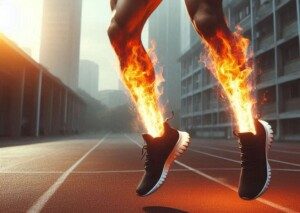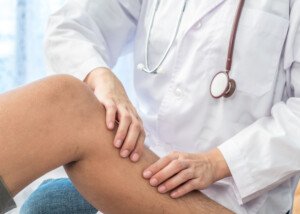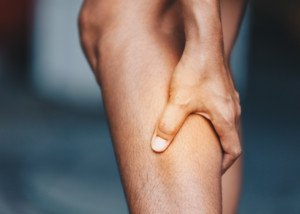With repetitive jumping exercises such as jumping rope, box jumps or other plyometrics, the burning in your calves can be the very first thing that forces you to stop the activity.
And that includes even if you still have plenty of wind.
This discomfort is often a sign that your muscles are working hard and undergoing specific physiological changes to meet the demands of the activity.
Muscle Fatigue and Lactic Acid Buildup
One primary reason for the burning sensation in your calves during repetitive jumping is muscle fatigue.
The calves take a good hit when doing repetitive jumping, especially if it’s rapid and close to the floor, since the shallower the jumping, the more rapidly you can do it.
And usually, this kind of rapid, shallow jumping can be sustained long enough to build up a big burn in your calf muscles.
As you continuously perform jumps, your calf muscles contract repeatedly, leading to the depletion of adenosine triphosphate (ATP), the primary energy currency in muscles.
To compensate for this energy deficit, your muscles rely on anaerobic metabolism, which produces lactic acid as a byproduct.
The accumulation of lactic acid contributes to the burning sensation.
While lactic acid itself is not the cause of muscle soreness, the hydrogen ions released during its production can lower the pH level in your muscles, leading to an acidic environment.
This acidic environment can irritate nerve endings and contribute to the sensation of burning.
Increased Blood Flow and Oxygen Demand
Jumping exercises demand increased blood flow to the working muscles to provide oxygen and nutrients necessary for energy production.
The calf muscles, being actively engaged in the jumping motion, require a heightened supply of oxygenated blood.
The increased blood flow can lead to a temporary swelling or pump sensation in the muscles, contributing to the “my calves are on fire” feeling.
Additionally, the oxygen demand during intense exercise may exceed the available supply, resulting in a switch to anaerobic metabolism.
This anaerobic state further contributes to lactic acid buildup and the associated burning sensation.
Microscopic Muscle Damage
Repetitive jumping can cause microscopic damage to muscle fiber.
This damage occurs due to the eccentric (lengthening) contractions that happen when the calves absorb the impact upon landing from each jump.
The body responds to this microtrauma by initiating repair processes, which can lead to inflammation and soreness.
The accumulation of these microtears and subsequent repair processes can contribute to the burning sensation in your calves.
Foot and Ankle Biomechanics
The biomechanics of your foot and ankle play a crucial role in the distribution of forces during repetitive jumping.
The main calf muscles are heavily involved in plantarflexion (pointing the toes downward so that you can propel off a surface) and play a significant role in absorbing and generating force during jumps.
Improper jumping mechanics or inadequate ankle flexibility can lead to an uneven distribution of force, placing excessive stress on certain areas of the calf muscles.
This stress, coupled with the repetitive nature of jumping, can contribute to localized fatigue and the burning sensation.
Solutions to Burning Calves with Repetitive Jumping
Along with making sure you have proper footwear, proper form and a safe surface for the repetitive jumping (e.g., lumpy grass could twist an ankle), just keep on doing what you’re doing so that your body can build up stamina for this activity.
Over time, you’ll notice that it takes longer or more jumps before you begin feeling as though your calves are on fire.
You also must be consistent! If you take time off from the jumping, your return will be met with a much earlier-onset of the burning.
You need do the jumping drills only once a week to build up stamina (but with consistency!), but of course, twice-weekly sessions will make the buildup of tolerance occur faster.
Finally, make sure you’re properly hydrated.










































